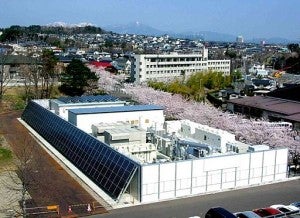
Coast to Coast and Across the Electric System, Microgrids Provide Benefits to All
Microgrids are getting a lot of attention. Yet how they’re developed could dramatically alter today’s electricity system.
At the most obvious level, microgrids could disrupt today’s utilities and their regulated-monopoly business model, because they challenge the centralized paradigm. In a nutshell, microgrids are localized power grids that have the ability to disconnect from the main, centralized grid to operate independently when the main power grid experiences disturbances. This significantly boosts grid resilience. For almost a century, large centralized power plants have generated electricity and delivered that energy over high-voltage transmission lines to customers. But with microgrids, all that could change.
Less obviously, microgrids challenge the basic assumption that the power grid must be controlled by a monopoly electric utility. Multiple microgrids on the south side of Chicago, for example, could be owned by different entities (not just a utility or even a platform provider, which would provide an exchange between customers and distributed energy generators) with contract arrangements among them controlling the sharing of power. Put another way, microgrids open the distribution system to some level of competition and, thereby, engage entrepreneurs and advance innovation.
[Tweet “Coast to Coast and Across the Electric System, #Microgrids Provide Benefits to All from @DickMunson”]
Types of microgrids
Interest in microgrids grew substantially after Hurricane Sandy wiped out much of the centralized infrastructure and power lines throughout the Northeast. Even before that major storm, however, concerns were increasing about power grid failures, 80-90 percent of which start at the distribution level, or with local lines. These outages cost the U.S. economy $336 billion between 2003 and 2012.
Microgrids are attractive since they offer the ability to isolate outages and increase reliability. Yet they also have the potential to reduce pollution, embrace clean energy sources, beef up cyber security, and cut costs for utilities and their customers.
These small-scale versions of today’s centralized power grid come in numerous shapes and sizes. Most frequently they are organized around a single campus, such as a hospital or university (e.g., Illinois Institute of Technology), but they could be within an industrial park (e.g., Eastman Business Park) or a mixed-use community (e.g., Chicago’s Bronzeville neighborhood).
Difference of opinions, benefits for all
Stakeholders have different views on microgrids, but most agree, microgrids offer tangible benefits. Environmentalists, for example, tend to see them as opportunities to enable clean, distributed generation, such as community solar farms, yet they want to ensure the microgrid isn’t fueled by dirty, diesel-fired units exclusively. Third-party developers tend to have a similar perspective and hope microgrids offer new business opportunities. Municipalities and rural communities think microgrids enhance reliability, as well as expand local economic development.
Even a growing number of utilities see microgrids as complements to their business models, particularly as they roll out smart meters and advanced wires infrastructure. Commonwealth Edison (ComEd), for instance, just introduced legislation that would allow it to invest $300 million to build several microgrids, including at the Illinois Medical District, the Aurora FAA facility, and the Chicago Heights water pumping and treatment facility.
Yet ComEd, not surprisingly, wants to control the microgrids and own the distributed generators (e.g., solar arrays and cogeneration units) within them, thereby expanding its monopoly to these decentralized power plants, as well as wires. And, utility interest in building, owning, and operating microgrids is spreading across the country: from Central Hudson Gas & Electric in New York to Duke Energy in North Carolina, DTE Energy in Michigan, and Southern California Edison.
While microgrids can advance clean, distributed energy, resiliency, and innovation, their future depends upon policies that ensure market signals advance such goals and minimize monopoly barriers. Microgrids, in fact, force us to confront certain questions: will we support the status quo of centralized, monopoly-owned power plants or embrace innovation and competition? Will we rely solely on regulation or also on contracts to advance clean energy?











2 Comments
Dick, after heaping scorn on utilities and touting the advantages of microgrids (the ability to isolate outages, increase reliability, reduce pollution etc.) you select a microgrid proposed by ComEd – Illinois’s utility – as your shining public example (Chicago’s Bronzeville neighborhood).
Your readers should probably know that the changes you’re proposing – removing electricity generation from any public oversight whatsoever – is a poster child for the current right-wing, small-government push to privatize public infrastructure. It would give unregulated large corporations unfettered control over electricity generation and prices, and is 180 degrees removed from the disingenuous, populist message you attempt to convey.
Bob:
Thanks for your note. Microgrids, as you know, can take many forms and business structures. I highlighted the proposed microgrid in Chicago’s Bronzeville neighborhood because it would uniquely serve a multi-use community, including residences, commercial businesses and even a critical police station; you’re correct in noting the current proposal would have it controlled by ComEd but regulated by the Illinois Commerce Commission. Other microgrids could be privately- or government-owned and linked to other microgrids or the larger grid through a mixture of contracts and regulation.
Dick